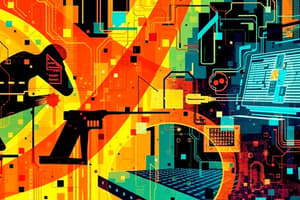Podcast
Questions and Answers
What is a traditional problem associated with finding digital evidence due to the nature of computer crime investigators playing multiple roles?
What is a traditional problem associated with finding digital evidence due to the nature of computer crime investigators playing multiple roles?
- Limited knowledge of technological advancements
- Restrictions from digital privacy laws
- Excessive costs of investigative tools
- Lack of resources leading to complications (correct)
Why is digital evidence considered fragile in forensic investigations?
Why is digital evidence considered fragile in forensic investigations?
- It is heavily regulated by law
- It is manufactured and not original
- It requires special equipment to collect
- It is susceptible to various external factors (correct)
What is a significant challenge when analyzing digital evidence in cyber crime investigations?
What is a significant challenge when analyzing digital evidence in cyber crime investigations?
- The need to analyze all potential evidence (correct)
- The use of outdated technology in investigations
- Having too much irrelevant data available
- Abundance of centralized databases
What issue is raised by the expensive nature of conducting proper digital evidence investigations?
What issue is raised by the expensive nature of conducting proper digital evidence investigations?
What complicates the retrieval of potential evidence in today’s cyber crime investigations?
What complicates the retrieval of potential evidence in today’s cyber crime investigations?
What must be demonstrated to establish probable cause for a search warrant?
What must be demonstrated to establish probable cause for a search warrant?
What is necessary for seizing equipment during an investigation?
What is necessary for seizing equipment during an investigation?
In what scenario might a no-knock warrant be justified?
In what scenario might a no-knock warrant be justified?
What type of evidence can be seized without judicial authority?
What type of evidence can be seized without judicial authority?
Why is it important to involve computer experts in the warrant application process?
Why is it important to involve computer experts in the warrant application process?
What is the first step involved in serving a warrant?
What is the first step involved in serving a warrant?
Which of the following is NOT included in the process of securing a crime scene?
Which of the following is NOT included in the process of securing a crime scene?
What should be documented at a minimum when processing the scene?
What should be documented at a minimum when processing the scene?
Why should photograph/video documentation be performed at a crime scene?
Why should photograph/video documentation be performed at a crime scene?
When might external specialists be needed during a warrant execution?
When might external specialists be needed during a warrant execution?
What is the purpose of preparing a tool kit for a search scene?
What is the purpose of preparing a tool kit for a search scene?
Which team is responsible for the final handling of evidence during a search?
Which team is responsible for the final handling of evidence during a search?
What does SMEAC stand for in the context of planning?
What does SMEAC stand for in the context of planning?
Which type of bags is specifically designed to prevent loss of data due to static electricity?
Which type of bags is specifically designed to prevent loss of data due to static electricity?
What equipment is essential for creating backups during a forensic examination?
What equipment is essential for creating backups during a forensic examination?
Multiple roles for computer crime investigators can complicate forensic investigations due to resource limitations.
Multiple roles for computer crime investigators can complicate forensic investigations due to resource limitations.
Digital evidence is considered stable and unaffected by environmental factors.
Digital evidence is considered stable and unaffected by environmental factors.
The complexity of cyber crime investigations is increasing due to the growing sophistication of criminals.
The complexity of cyber crime investigations is increasing due to the growing sophistication of criminals.
The costs associated with correctly conducting digital evidence investigations can lead to potential lawsuits.
The costs associated with correctly conducting digital evidence investigations can lead to potential lawsuits.
Legislation regarding cyber crime is advancing at a faster rate than technology.
Legislation regarding cyber crime is advancing at a faster rate than technology.
Application for a search warrant should be reviewed by computer experts and legal counsel.
Application for a search warrant should be reviewed by computer experts and legal counsel.
A no-knock warrant is justified only for minor offenses regardless of circumstances.
A no-knock warrant is justified only for minor offenses regardless of circumstances.
Criminal contraband may be seized without judicial authority.
Criminal contraband may be seized without judicial authority.
Probable cause requires demonstrating that a crime has been committed and evidence exists in a particular location.
Probable cause requires demonstrating that a crime has been committed and evidence exists in a particular location.
Dumpster-diving for potential evidence is an unacceptable practice in computer forensics.
Dumpster-diving for potential evidence is an unacceptable practice in computer forensics.
Multiple boot disks are considered computer-specific equipment.
Multiple boot disks are considered computer-specific equipment.
Evidence tape is not considered traditional equipment in law enforcement.
Evidence tape is not considered traditional equipment in law enforcement.
Antistatic bags help prevent data loss due to static electricity.
Antistatic bags help prevent data loss due to static electricity.
The Scene Security Team is responsible for document preparation.
The Scene Security Team is responsible for document preparation.
The SMEAC planning model includes an Avenues of approach and escape component.
The SMEAC planning model includes an Avenues of approach and escape component.
Dealing immediately with dangerous individuals is not part of securing the crime scene.
Dealing immediately with dangerous individuals is not part of securing the crime scene.
Photograph/video documentation can strengthen defense arguments that officers corrupted evidence.
Photograph/video documentation can strengthen defense arguments that officers corrupted evidence.
Locating and securing all computers is one of the initial steps when serving a warrant.
Locating and securing all computers is one of the initial steps when serving a warrant.
Removing all personnel from the immediate area of evidence is not necessary.
Removing all personnel from the immediate area of evidence is not necessary.
Collecting literature related to the offenses is unnecessary during the scene processing.
Collecting literature related to the offenses is unnecessary during the scene processing.
Flashcards
Forensic Investigation
Forensic Investigation
A legal method to find digital evidence in cyber crime scenes.
Traditional Problems (Digital Evidence)
Traditional Problems (Digital Evidence)
Challenges in collecting and analyzing digital evidence, including multiple roles, fragility, volume, high cost, complexity, and slow legislation.
Multirole Operation
Multirole Operation
Investigators often have to take on multiple roles (e.g., case supervisor, investigator, crime scene technician, forensic scientist) due to resource limitations.
Fragility of Evidence
Fragility of Evidence
Signup and view all the flashcards
Analysis of all Evidence
Analysis of all Evidence
Signup and view all the flashcards
Pre-Search Activities
Pre-Search Activities
Signup and view all the flashcards
Volatile Evidence
Volatile Evidence
Signup and view all the flashcards
Judicial Authority
Judicial Authority
Signup and view all the flashcards
Expertise for Digital Evidence
Expertise for Digital Evidence
Signup and view all the flashcards
Social Engineering in Investigation
Social Engineering in Investigation
Signup and view all the flashcards
When are multiple warrants needed?
When are multiple warrants needed?
Signup and view all the flashcards
SMEAC - What does it stand for?
SMEAC - What does it stand for?
Signup and view all the flashcards
On-scene personnel roles
On-scene personnel roles
Signup and view all the flashcards
Tool kit for digital evidence
Tool kit for digital evidence
Signup and view all the flashcards
What are essential computer-specific tools?
What are essential computer-specific tools?
Signup and view all the flashcards
Securing a Scene
Securing a Scene
Signup and view all the flashcards
External Specialists
External Specialists
Signup and view all the flashcards
Documentation
Documentation
Signup and view all the flashcards
Photograph/Video Documentation
Photograph/Video Documentation
Signup and view all the flashcards
Knock, Notice, Document
Knock, Notice, Document
Signup and view all the flashcards
Digital Evidence Fragility
Digital Evidence Fragility
Signup and view all the flashcards
Multiple Roles in Digital Investigations
Multiple Roles in Digital Investigations
Signup and view all the flashcards
Importance of Full Evidence Analysis
Importance of Full Evidence Analysis
Signup and view all the flashcards
Legislation Lagging Behind Technology
Legislation Lagging Behind Technology
Signup and view all the flashcards
Why Is Secure Search and Seizure Needed?
Why Is Secure Search and Seizure Needed?
Signup and view all the flashcards
What is SMEAC?
What is SMEAC?
Signup and view all the flashcards
Who are the on-scene personnel?
Who are the on-scene personnel?
Signup and view all the flashcards
What does a digital evidence kit include?
What does a digital evidence kit include?
Signup and view all the flashcards
What computer-specific tools are essential?
What computer-specific tools are essential?
Signup and view all the flashcards
What's the purpose of reviewing a warrant application?
What's the purpose of reviewing a warrant application?
Signup and view all the flashcards
What two things must be demonstrated for probable cause?
What two things must be demonstrated for probable cause?
Signup and view all the flashcards
Seizing Equipment: What needs to be justified?
Seizing Equipment: What needs to be justified?
Signup and view all the flashcards
When might a 'no-knock' warrant be justified?
When might a 'no-knock' warrant be justified?
Signup and view all the flashcards
What are some types of evidence that can be seized without a warrant?
What are some types of evidence that can be seized without a warrant?
Signup and view all the flashcards
Serving a warrant
Serving a warrant
Signup and view all the flashcards
Securing a crime scene (digital)
Securing a crime scene (digital)
Signup and view all the flashcards
Importance of documentation
Importance of documentation
Signup and view all the flashcards
Study Notes
Computer Forensics and Cyber Crime: Searching and Seizing Evidence
- Computer forensics involves a legal approach to finding digital evidence in cybercrime scenes.
- Pre-search activities include:
- Gathering information to prepare for scene arrival.
- Determining the number, type, and size of computers present.
- Assessing risks from personnel affecting evidence.
- Recognizing the volatility of evidence.
- Obtaining judicial authority for data gathering.
- Seeking expertise from non-departmental experts.
- Engaging in social engineering.
- Conducting dumpster diving for potential evidence.
- Warrant preparation and application:
- Warrants need review by legal counsel and computer experts before submission.
- Probable cause is mandatory to demonstrate a committed crime at the specific location.
- Seizing equipment:
- Justification for seizing equipment is required (not just the search).
- Explicit permission is needed to seize all hardware and storage devices to ensure constitutional justification.
- Criminal contraband, fruits of the crime, or evidence may be seized without a warrant.
- No-knock warrants:
- No-knock warrants might be used in exigent circumstances:
- Nature of the crime.
- Potential for evidence destruction.
- Sophistication and maturity of the target.
- Absence of the resident.
- No-knock warrants might be used in exigent circumstances:
- Secondary/multiple warrants:
- Secondary warrants may be needed in cases dealing with complex crimes, such as identity theft related to drug trafficking. This could also be true for networked computers with off-site storage.
- Plan Preparation and Personnel Gathering:
- Use SMEAC (Situation, Mission, Execution, Avenues of approach and escape, Communications) for pre-investigation planning.
- On-scene personnel:
- On-scene personnel may play various roles (e.g., case supervisor, arrest team, scene security, interview team, sketch/photo team, physical search team, seizure team).
- Seizing team would be responsible for bagging/tagging evidence.
- Traditional equipment:
- Evidence tape, packing tape, evidence storage containers and labels.
- Anti-static bags, conductive bags, and Faraday bags to prevent loss of data and shield wireless devices.
- Computer-specific Equipment:
- Multiple boot disks, backup hardware, new hard drives, color scanners, color printers, anti-virus software (must be the most up-to-date), imaging software, and application software.
- On-scene activities:
- Steps involved in serving a warrant: Knock, Notice, Document.
- Securing the crime scene, including dealing with dangerous individuals, hazards, and removing personnel from the area.
- Ascertaining network connections for appropriate actions.
- Disabling network access (ideally by a network administrator) and protecting computers.
- Collecting literature related to the underlying activities or offenses.
- Determining the need for external specialists (e.g., mainframes, minicomputers, hacker computers).
- Documenting date, time, description of computer (including damage), identifying information for investigators and personnel, finding all present persons, all available clues & leads, & any investigative software used.
- Photos/videos used as evidence to counter corruption and contamination efforts by opposing sides.
- Identifying potential evidence (non-digital, trace evidence, like hair, fibers, and fingerprints), as well as any other computer components (external hard drives, peripherals).
- Documentation of circumstantial connections include post-its, printouts, & paper types.
- Investigating potential evidence like desktops, monitors, keyboards, phones, wallets/purses, clothing, trash cans/bins, printers, and the computer itself.
- Seizure and documentation of evidence for the warrant scope. All annotation is done in ink. Comprehensive notes are taken.
- Seizing computer steps: Document the status (photos, sketches, etc.) before powering off the computer, include back of computer and connections. Place evidence tape over disk openings after powering off and label all cords & empty slots.
- Bagging and tagging:
- Use chain of custody logs to track all evidence.
- Labels should contain investigator initials, date found, and location of evidence.
- Transport and packaging:
- Use protective measures to avoid damage from temperature, oil, dirt/dust, magnetic fields, and other environmental factors.
- Post-Seizure activities:
- Who controlled the digital evidence, when and how was it collected/stored, where was it when collected, what kind of device held the evidence, who had access to equipment, and who owned the equipment.
- Rely on traditional transport to exit the crime scene and properly record the contents being transferred, review shipping manifests, and enter into appropriate evidence control systems for analysis.
Studying That Suits You
Use AI to generate personalized quizzes and flashcards to suit your learning preferences.




